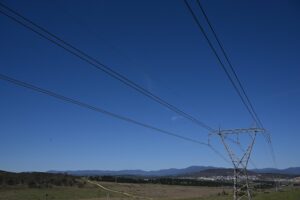Our earlier articles suggested that current demand charge-based network tariffs could result in households installing batteries and operating them in such a way that they may reduce a household’s bills, but not be particularly effective at reducing the network’s annual peak(s). The same result could occur if a household instead chooses some other form of control, such as having their grid connection capacity capped at a certain level.
In other words, the current demand charge-based network tariffs encourage households to reduce their own peaks rather than the networks’ peaks. To quantify this effect we have calculated the reduction in the customers’ peaks that is required to obtain a certain reduction in the network peak.
The following charts show this analysis for two different network tariffs, one that is applied only over the summer months (Network tariff 1) and one that is applied all year (Network tariff 2). They are based on the average of 10 repetitions of calculations applied to a randomly selected 20% of customers (called ‘participating customers’).
 The left hand y axis shows the total reduction in average participating customer demand caused by it being capped at certain kW levels (x axis). The right hand y axis shows the corresponding reduction in the network peak – averaged per participating customer. The customer calculations are based on difference between their old peak and their new peak within the demand charge window each day.
The left hand y axis shows the total reduction in average participating customer demand caused by it being capped at certain kW levels (x axis). The right hand y axis shows the corresponding reduction in the network peak – averaged per participating customer. The customer calculations are based on difference between their old peak and their new peak within the demand charge window each day.
The network calculations allow for the fact that, as one peak is reduced, another will become the peak, and so it must be reduced as well. Thus, the total peak reduction equals the old peak minus the new peak (which is most likely on a different day).
At a 3kW cap, for Network tariff 1, a reduction of 0.57kW/participating customer in the network annual peak requires a net annual reduction of 15.1kW by the average participating customer (which is a 26.5kW customer reduction for a 1kW network reduction) – a significant dead weight loss. For Network tariff 2, because the demand charge is applied all year, a 187kW participating customer reduction is required for a 1kW network reduction.
Another way to assess this loss of ‘utility’ for the participating customer is to add up all the kWh they ‘lost’ because of the cap (or didn’t lose but only because they paid for a battery). In this case, Network tariff 1 results in 39kWh being ‘lost’ for every 1kW network reduction, and Network tariff 2 results in 267 kWh being ‘lost’.
This is of course why the $/kW charge applied through demand tariffs is so much lower than the network LRMC. However this reduction only addresses the symptom, not the problem, which is that the demand charge targets customer peaks on a large number of days, not customer demand during the highest network peaks on a much more limited number of days.
Rob Passey is a Senior Research Associate at the Centre for Energy and Environmental Markets (CEEM) at the University of NSW, Policy Analyst at the Australian PV Institute and Senior Consultant at IT Power (Australia).
Navid Haghdadi is a (you wouldn’t believe what he can do with Matlab) PhD Candidate at CEEM UNSW.








